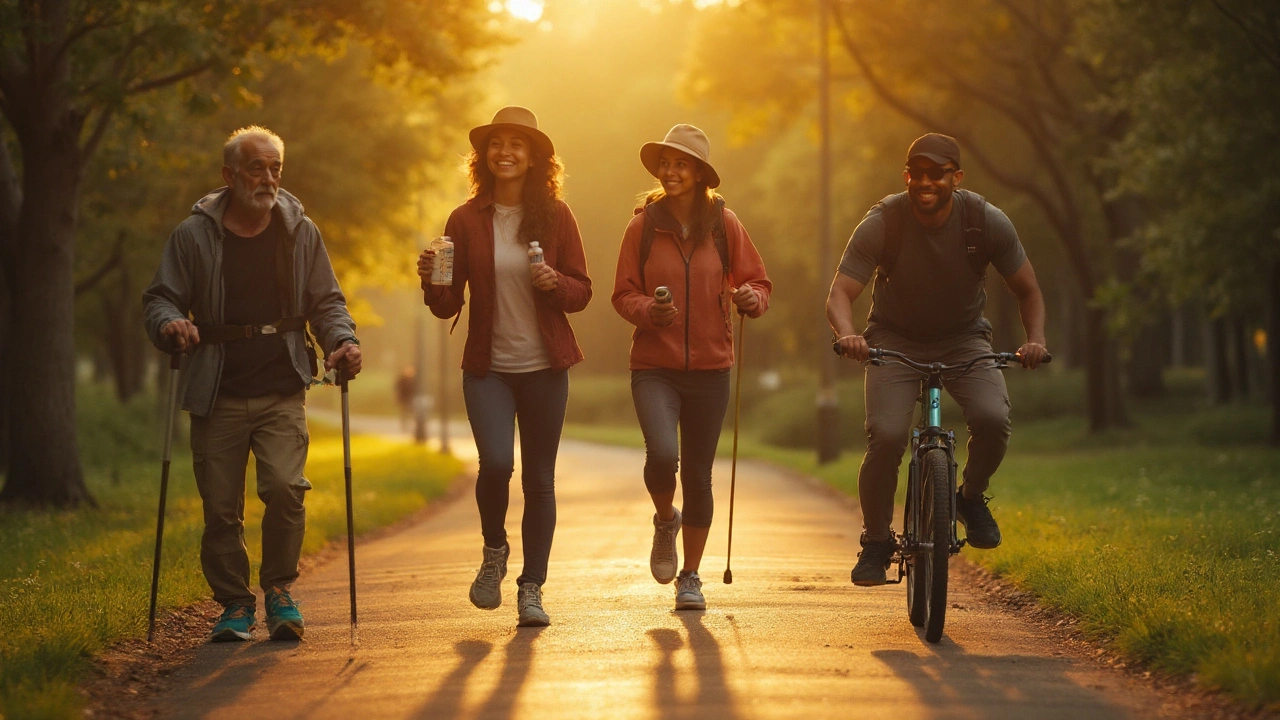Stress doesn’t just live in your head-it seeps into your joints. High-stress weeks can crank up inflammation, tighten muscles, and tweak how you move, which piles pressure on cartilage and tendons. If your knees ache after tense deadlines or your hands flare when life gets loud, that link isn’t imaginary. Your body’s stress system can fuel joint wear and flare-ups. The good news? You can train it down.
This guide shows exactly how to lower stress in ways that protect cartilage, reduce inflammation, and keep you moving. I’m in Bristol, where the weather changes its mind twice before lunch, so the routines here work in real life: rainy days, busy commutes, stubborn pain. Expect practical steps, not platitudes-what to do today, what to track this week, and when to get help.
TL;DR: What Works Fast and Keeps Joints Safe
- Breathe first, move second: A 5-minute exhale‑focused breathing set lowers stress quickly; then low-impact activity (walk, cycle, swim) protects joints and mood.
- Sleep is joint armor: 7-9 hours reduces inflammatory markers linked to pain; start with a 30‑3‑2‑1 wind‑down (caffeine cut 6-8h before bed, last meal 3h, work 2h, screens 1h).
- Lift light, often: Two short strength sessions a week stabilize joints and reduce pain sensitivity; think bands, bodyweight, slow tempo.
- Eat anti-inflammatory basics: More oily fish, olive oil, nuts, beans, and colorful veg; fewer ultra‑processed snacks and sugary drinks.
- Use the 3×3 rule on high‑stress days: three 3‑minute resets (breathing, walk, stretch) spaced across your day.
Why believe this? Stress hormones and pro‑inflammatory cytokines (like IL‑6, TNF‑α) rise under chronic stress and are tied to worse joint pain. Randomized trials show breathwork, CBT, mindfulness, and exercise reduce stress and pain. The NHS and NICE in the UK continue to recommend regular physical activity and strength training for joint conditions; EULAR and ACR highlight mind‑body and sleep interventions as useful add‑ons.
Step‑by‑Step: Build a Routine That Lowers Stress and Protects Your Joints
Job 1: Understand the stress-joint link (so you take the plan seriously).
When you’re stressed, cortisol and adrenaline rise. Short bursts help you focus. Long stretches, though, ramp up inflammation and tighten muscles. That combo increases pain sensitivity and can alter gait and posture, which adds load to cartilage. Studies in Arthritis Care & Research and the BMJ have linked chronic stress and poor sleep to higher pain scores in osteoarthritis and inflammatory arthritis. You don’t need a lab to feel it: after a rubbish night, stairs feel steeper.
Job 2: Set your baseline (2 days of quick tracking).
- Pain today (0-10), stiffness (0-10), and mood (0-10). Note your biggest stressor.
- Sleep last night (hours + quality), movement (minutes), and meals (roughly what/when).
- Goal: spot one trigger you can influence (late coffee, skipped lunch, laptop posture, doomscrolling at 11 p.m.).
Heuristic: If pain spikes >2 points after high‑stress days, treat stress work as a core intervention, not a “nice to have.”
Job 3: Daily stress resets that don’t bash joints.
- Exhale‑heavy breathing (5 minutes): Try 4‑second inhale, 6‑ to 8‑second exhale. Evidence from a 2023 Stanford trial showed breathwork can outperform mindfulness for immediate anxiety relief.
- Physiological sigh (1 minute): Two short inhales through the nose, one long exhale through the mouth. Do 10-15 cycles before meetings or after bad traffic.
- Box breathing (4‑4‑4‑4) if you like rhythm. Great at a desk or on a bus. No kit, no excuses.
Job 4: Move in ways that lower stress and support cartilage.
- Low‑impact cardio: 20-30 minutes, 3-5 days a week. Options: brisk walk (Active 10 is solid), stationary bike, swimming. Keep intensity at “I can talk but not sing.”
- Strength training: Two short sessions weekly. Prioritize hips, glutes, quads, and core to stabilize knees and back. Use bands or light dumbbells. Slow reps, full control, no joint pinching.
- Mobility: 8-10 minutes daily. Ankles, hips, thoracic spine, wrists. Smooth circles, gentle end‑range holds. If a move hurts sharply, scale it down or swap.
- Tai chi or yoga: 1-2 sessions/week. Evidence supports small‑to‑moderate improvements in pain and function in arthritis. Choose joint‑friendly classes; tell the instructor about your joints.
Rule of thumb: Pain during exercise should be 0-3/10 and settle within 24 hours. If it lingers or spikes, reduce range, load, or time by 20-30% next session.
Job 5: Sleep like your joints depend on it (because they do).
- 30‑3‑2‑1 wind‑down: Finish large meals 3 hours before bed, last caffeine 6-8 hours before, stop work 2 hours before, screens off 1 hour before. Read, stretch, or breathe instead.
- Keep it dark and cool: 17-19°C room, blackout curtains. Noise machine if the street’s rowdy.
- If you wake at 3 a.m., do one minute of breathing and a light body scan. Don’t check the time.
Short sleep can raise CRP and IL‑6-markers linked to pain. Fixing sleep won’t cure arthritis, but it often trims pain enough to make movement easier, which compounds benefits.
Job 6: Eat to calm the fire, not feed it.
- Go Mediterranean-ish: oily fish 2x/week (salmon, mackerel), extra‑virgin olive oil daily, nuts and seeds, whole grains, legumes, piles of veg and berries.
- Protein at each meal: helps muscle repair and satiety. Greek yogurt, eggs, tofu, chicken, beans.
- Swap ultra‑processed snacks for simple ones: fruit + nuts, cheese + oatcakes, hummus + carrots.
- Hydrate: aiming for pale straw‑coloured wee by midday.
Evidence: Diets higher in omega‑3s and polyphenols link to lower inflammatory markers. You’ll feel the difference in energy and recovery before lab values change.
Job 7: Supplements-use with purpose.
- Omega‑3 (EPA/DHA): has the best evidence for lowering systemic inflammation; useful if you rarely eat fish. Check with your GP if you’re on blood thinners.
- Turmeric/curcumin: mixed results; may help some people with pain. Needs black pepper (piperine) or a formulated version for absorption.
- Magnesium glycinate: can support sleep quality; avoid if you have kidney issues without medical advice.
Always check interactions if you’re on meds for arthritis, blood pressure, or mood.
Job 8: Work and home tweaks that lower load automatically.
- Micro‑breaks: 2 minutes every 30-45 minutes-stand, shoulder rolls, wrist circles, two minutes of marching in place.
- Ergonomics: Screen at eye level, elbows near 90°, feet flat, hips slightly above knees. If you’re on trains, back support and frequent standing matter.
- Heat before, ice after: warm up stiff joints in the morning; use a cold pack after any activity that swells a joint.
Job 9: Mind support-because stress isn’t just physical.
- CBT or ACT: solid evidence for reducing pain interference and stress. Ask your GP about NHS options or local therapy services.
- Mindfulness in small bites: 10 minutes daily. Cochrane reviews show small‑to‑moderate improvements in chronic pain and mood.
- Social buffer: weekly chat with a friend or group. Loneliness ramps stress; connection calms it.
Job 10: Build your two‑week test plan.
- Morning (10 minutes): breathing + gentle mobility + short walk if possible.
- Lunch (5-10 minutes): walk or light stretch, snack with protein and fibre.
- Afternoon (3 minutes): physiological sigh set + posture reset.
- Evening (20-30 minutes): low‑impact cardio day 1, 3, 5; strength day 2, 6; rest/mobility day 4, 7.
- Night: 30‑3‑2‑1 wind‑down; dim lights; notebook by the bed for a quick brain dump.
Track pain/stiffness/mood daily (0-10). If your average pain falls by ≥1 point after two weeks, keep going. If not, adjust: drop intensity 20%, add sleep focus, or ask your GP/physio for a review.

Examples, Checklists, and Tools You Can Use Today
Example routines for different lives.
Office worker, typing all day
- Before work: 5 minutes exhale‑heavy breathing + hip/wrist circles; brisk 10‑minute walk if dry enough.
- Every 45 minutes: stand, roll shoulders, 20 calf raises. Two minutes, done.
- Lunch: 15‑minute walk round the block; tuna and bean salad with olive oil.
- After work: 20 minutes cycling or fast walk; strength on Tues/Fri (glute bridges, wall sits, rows, dead bugs).
- Evening: screens off at 9, stretch hamstrings and hip flexors, sleep by 10:30-11.
Parent with limited time
- Morning: 3 minutes physiological sigh + 5 minutes mobility while the kettle boils.
- School run: power‑walk the last 10 minutes; stairs instead of lift once daily.
- Nap/midday: 8-10 minutes strength circuit: sit‑to‑stand, incline push‑ups on counter, band rows, side plank.
- Evening: 15 minutes yoga or tai chi video; phone in another room by 9 p.m.
Manual worker on feet all day
- Pre‑shift: 5 minutes gentle joint warm‑up; supportive shoes and insoles if needed.
- Breaks: two minutes of paced breathing and calf/hip flexor stretches.
- Post‑shift: 10 minutes light cycling or swimming to flush stiffness; ice sore spots for 10 minutes.
- Twice a week: short strength session focusing on glutes, quads, posterior chain to share the load.
Quick comparison: what calms stress fastest vs. what protects joints longest.
- Fastest calm in 1-5 minutes: exhale‑focused breathing, physiological sigh, a brisk 5‑minute walk outdoors, heat pack on stiff joints.
- Medium‑term (days to weeks): consistent sleep schedule, 3-5 low‑impact cardio sessions/week, two strength sessions, Mediterranean‑style diet.
- Long‑term (months): CBT/ACT, maintaining a supportive social routine, steady weight management, regular check‑ins with a physio.
Joint‑safe stress toolkit (checklist).
- Breathwork: exhale‑heavy timer saved on your phone.
- Movement: trainers by the door; resistance band by your desk.
- Heat/cold: microwaveable heat pack; small gel ice pack in the freezer.
- Sleep: blackout mask, cool room, nighttime routine written on a sticky note.
- Food: olive oil, tinned fish, nuts, frozen berries, beans-easy wins you’ll actually use.
Two‑minute posture and mobility reset (desk version).
- Neck: tip ear to shoulder, hold 10 seconds each side; chin tucks x10.
- Shoulders: slow circles x10 forward/back; band pull‑aparts x15.
- Hips/ankles: sit‑to‑stand x10; ankle circles x10 each direction.
- Finish: 1 minute of 4‑6 breathing.
Decision guide: What if pain flares during stress?
- Pain 0-3/10: keep routine; shorten range if needed; add heat before activity.
- Pain 4-6/10: swap high‑impact for low‑impact; reduce volume by 20-30%; add extra breathwork set and sleep focus.
- Pain 7+/10, swelling, warmth, or locking: rest the joint, ice 10 minutes on/20 off, elevate, and call your GP or physio. For known inflammatory arthritis, follow your flare plan.
Common pitfalls to avoid.
- Going “all in” for a week, then quitting. Go 1% daily, not 100% once.
- Chasing perfect form over pain signals. Comfortable control beats ego.
- Skipping strength work. Cardio is great; strong muscles are your shock absorbers.
- Late‑night scrolling. It’s gasoline on stress and steals sleep.
How I use this in the wild (a Bristol‑flavoured day).
Rainy morning? I do five minutes of exhale‑focused breathing by the window, then a 10‑minute mobility flow. If the sun peeks out, I walk the harbour for 12 minutes before sitting down. Lunch means a brisk lap around the block and a bean‑and‑tuna wrap. At 3 p.m., when my shoulders creep up to my ears, I do a one‑minute physiological sigh set and 20 calf raises. Dinner leans Mediterranean. Lights dim at nine, screens off, book open. It’s not magic, but my knees thank me.
Mini‑FAQ, Evidence Notes, and Next Steps
Does stress cause arthritis? No, stress doesn’t cause osteoarthritis or autoimmune arthritis. But it can worsen pain, stiffness, and flares by spiking inflammation and changing how you move. Reducing stress often makes any joint treatment plan work better.
Which exercises are safest when I’m stressed? Anything low‑impact and steady: brisk walking, cycling, swimming, tai chi, gentle yoga. Keep effort moderate. Avoid sudden plyometrics or long hill sprints when you’re tense.
Can cortisol damage cartilage? Chronically elevated stress hormones are linked with higher inflammatory mediators that can affect joint tissues and pain processing. It’s less about cortisol melting cartilage and more about a whole‑system nudge toward more pain and load-controllable with sleep, movement, and stress skills.
How fast will I feel better? Many people notice a small pain and mood shift within 7-14 days of consistent breathing, better sleep, and low‑impact movement. Bigger changes in strength and resilience take 6-12 weeks.
Are weighted squats bad for knees under stress? Not inherently. Technique and load matter. If you’re flared or exhausted, reduce depth and weight, or swap to sit‑to‑stand and wall sits for a week. Build back up.
Do I need a special diet? No. Start by adding: one veg at each meal, oily fish twice weekly, a handful of nuts daily, olive oil as your default fat. Then trim ultra‑processed snacks and sugary drinks. Simple beats perfect.
Any proof this mind‑body stuff isn’t just placebo? Yes. RCTs show breathwork and mindfulness reduce anxiety and pain interference; CBT/ACT improves functioning; sleep extension reduces inflammatory markers; regular exercise reduces pain and improves cartilage nourishment. Cochrane reviews back parts of this, and NHS/NICE guidelines still anchor on activity and strength.
When should I see a clinician? If you have swelling, warmth, redness, unexplained weight loss, fever, night pain that won’t settle, locking/giving way, or pain that doesn’t improve after 2-4 weeks of sensible changes. If you suspect an inflammatory arthritis flare, follow your plan and call your rheumatology team or GP.
What about meds and supplements? Don’t change prescribed meds without your clinician. If you’re adding omega‑3, turmeric, or magnesium, check for interactions-especially if you’re on anticoagulants, antiplatelets, or blood pressure meds.
Evidence notes (Plain English).
- NICE guidance for osteoarthritis emphasizes exercise and strength work; sleep and weight help symptoms.
- EULAR/ACR statements encourage physical activity and psychosocial support for arthritis management.
- 2019-2024 studies show poor sleep raises IL‑6 and CRP; improving sleep lowers pain sensitivity.
- 2023 Stanford trial: breathwork reduced anxiety more than mindfulness in the short term.
- Cochrane reviews: mindfulness and CBT provide small‑to‑moderate benefits for chronic pain.
Next steps (pick one from each line and start today).
- Breath: 5 minutes exhale‑heavy or 1 minute physiological sigh before your busiest block.
- Move: 10‑minute brisk walk after lunch or dinner, rain jacket ready by the door.
- Strength: 10‑minute set (glute bridges, wall sits, band rows, dead bugs) twice this week.
- Sleep: screens off at 9 p.m. tonight; set your room cool and dark.
- Food: swap crisps for nuts and an apple; drizzle olive oil on veg.
Troubleshooting by scenario.
- Busy week, zero time: Use the 3×3 rule-three 3‑minute resets-plus a single 12‑minute brisk walk after dinner.
- Pain spike after exercise: Next session, cut volume by 30%. Keep motion with shorter ranges. Add heat before, ice after.
- Can’t sleep through the night: Protect your wind‑down ritual. Try 10 minutes of reading + body scan. Avoid alcohol; it fragments sleep.
- Motivation tanked: Pair habits: breathwork while the kettle boils, calf raises while brushing teeth, stretch during TV ads. Schedule with calendar alerts.
- Weather is grim (hello, Bristol): Indoor cycling, stair intervals, yoga, or a mall/market walk. Consistency beats perfect conditions.
Do this for two weeks. Review your pain, sleep, and mood notes. Keep what helps, tweak what doesn’t. The combo of breath, sleep, low‑impact movement, and simple food changes is the engine. Strength is the chassis. Social support is the seatbelt. Together, they protect your joint health when life gets hectic.




Comments
14 Comments
Justin Hampton
This whole guide is just wellness propaganda wrapped in science-speak. Stress doesn't 'seep' into joints. That's poetic nonsense. Your knees hurt because you're overweight, sedentary, or old. Not because you had a bad day at work. I've seen people with chronic pain who meditate daily and still need replacements. Don't sell placebo as medicine.
Pooja Surnar
lol u think breathing is gonna fix arthritis? 😂 u need to stop being so soft. i work 12hr shifts in a factory with no breaks and my knees still work. u just wanna feel special by buying expensive supplements and doing yoga. eat less sugar, lift heavy, stop whining. science? more like pseudoscience with a pretty font. 🙄
Sandridge Nelia
This is actually one of the most practical guides I’ve seen on stress and joints! 🙌 I’ve been doing the 3×3 rule since last week and my hand stiffness has dropped from 7/10 to 3/10. The physiological sigh? Game changer before Zoom calls. Also, the sleep wind-down worked better than any sleep tracker I’ve tried. Big thanks for the Bristol realism-no toxic positivity here. 💪
Mark Gallagher
Let me be clear: the NHS and NICE guidelines are not gospel. They're influenced by pharmaceutical lobbying and political agendas. Breathwork? That's Eastern mysticism repackaged for millennials. Real joint health comes from hard work, discipline, and American-style grit-not 5-minute breathing exercises while sipping chamomile tea. If you want results, lift weights, eat meat, and stop complaining about your 'stress'.
Wendy Chiridza
I’ve been following the 30-3-2-1 wind-down for two weeks and my sleep quality has improved dramatically. I used to wake up at 3 a.m. every night. Now I’m asleep by 10:45. The only thing I changed was turning off screens an hour earlier. No magic, just consistency. Also, swapping sugary snacks for nuts and cheese made my afternoon energy crashes disappear. Simple works
Pamela Mae Ibabao
Okay but let’s be honest-this guide is just a glorified list of things you already know. Everyone knows sleep is important. Everyone knows movement helps. The real question is why people don’t do it. And the answer? They’re lazy. Or addicted to their phones. Or emotionally avoidant. This doesn’t fix the root problem: people don’t want to change. It’s easier to buy a mindfulness app than to face your trauma. So yeah, this is nice. But it’s not transformative. Just a distraction with footnotes.
Gerald Nauschnegg
Wait wait wait-I tried the exhale-heavy breathing and it made me dizzy. Like, actually lightheaded. Is that normal? I did it for 5 minutes like it said. My wife thought I was having a panic attack. Should I be worried? Or is this just my body rejecting the ‘wellness cult’? I’m not mad, I’m just confused. Also, can I do this while driving? I’m asking for a friend. (It’s me.)
Palanivelu Sivanathan
My friend, the body is a temple... but also a mirror of the soul!!! When you are stressed, your joints scream because your spirit is trapped in the machine of modernity!!! The breath is not just air-it is the breath of the universe entering your marrow!!! Yoga is not exercise-it is a ritual to reclaim your divine rhythm from the algorithmic chains!!! Wake up!!! The system wants you broken!!!
Joanne Rencher
I read this and thought ‘oh good, another list’. Then I actually tried the 3×3 rule. Did it for three days. Didn’t notice anything. Still woke up with stiff knees. Still felt like crap. I’m not against this stuff, I just don’t have the energy to ‘try’ anymore. I’ve tried everything. The guide is fine. But I’m tired. That’s my update.
Erik van Hees
Let me break this down scientifically. The Stanford 2023 breathwork study? Sample size was 87. The CBT meta-analyses? Mostly small, short-term trials. The ‘Mediterranean diet’ claim? Correlation ≠ causation. And who wrote this? Someone who’s never had to work two jobs and care for a sick parent. Real people don’t have time for ‘physiological sighs’ between Zoom meetings and school drop-offs. This is wellness for the privileged. Don’t mistake convenience for cure.
Cristy Magdalena
I used to do all this. Breathwork. Sleep hygiene. Anti-inflammatory diet. I did it for 18 months. My pain got worse. My doctor said my joints were ‘too far gone’. I didn’t give up because I was lazy-I gave up because it didn’t work. And now I’m on biologics. So please don’t tell me I just didn’t try hard enough. This isn’t motivation porn. It’s emotional labor disguised as advice. I’m not mad. I’m just... done.
Adrianna Alfano
As someone from India who moved to the US, I’ve seen both sides. In my village, people just worked through pain. Here, people treat pain like a puzzle to solve. This guide? It’s a beautiful bridge between the two. I use the desk reset every day. My mom in Kerala does the same with her morning chai and shoulder rolls. It’s not about perfection-it’s about showing up. And that’s enough. 🙏
Casey Lyn Keller
Who funded this? I’m not saying it’s wrong, but the timing is suspicious. Right after that big pharma ad campaign about ‘stress-induced inflammation’. And why no mention of environmental toxins? Or glyphosate? Or 5G? The body’s response to stress is real, but it’s a symptom, not the cause. The real enemy is the system that makes us stressed in the first place. This guide is like handing someone a bandage while the house is on fire.
Jessica Ainscough
I’ve been sitting with this for a week. Tried the breathing. Did the walk after dinner. Didn’t track pain. Just did it because it felt right. My dog started following me around more. My partner said I stopped sighing all day. I don’t know if my joints are better. But I feel lighter. Maybe that’s the point. Not fixing. Just being. Thanks for not making it sound like a to-do list.
Write a comment